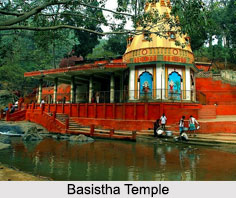 Dedicated to Lord Shiva, the Basistha Temple was constructed in 1764 by the Ahom king, Rajeswar Singha. Located in the south east corner of Guwahati, it is said that the history surrounding the temple dates back to the Vedic period. The temple also houses an ashram, the 835 bighas land for which was a gift from the Ahom king himself.
Dedicated to Lord Shiva, the Basistha Temple was constructed in 1764 by the Ahom king, Rajeswar Singha. Located in the south east corner of Guwahati, it is said that the history surrounding the temple dates back to the Vedic period. The temple also houses an ashram, the 835 bighas land for which was a gift from the Ahom king himself.
As per legends, it is said that the ashram was founded by the great Indian sage Vasishtha, after whom the temple and ashram are named. The temple stands on the bank of the mountain streams originating from the hills of Meghalaya which becomes the rivers Basistha and Bahini or Bharalu flowing through the city.
Legend of Basistha Temple
As per the Kalika Purana, the Basistha Temple has been described as one of the Shakti Peethas. The ashram associated with the temple has an interesting legend surrounding it. The sage Vasishtha once went to Kamarupa to worship the goddess Kamakhya and when the demon king Naraka tried to stop him, the sage cursed him. Vasishtha then built a hermitage at Sandhyachal and led his life meditating on Lord Shiva. It is believed that the sage died in this ashram.
Visiting Information on Basistha Temple
The Guwahati railway station is the closest at a distance of about 15 km from the Basistha Temple and the Lokpriya Bordoloi International Airport is the nearest at a distance of almost 33 km from the temple.
This article is a stub. You can enrich by adding more information to it. Send your Write Up to content@indianetzone.com.





















